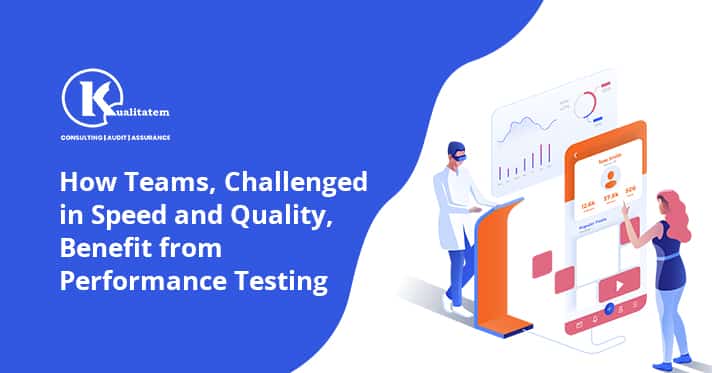Teams Benefit from Performance Testing in Speed and Quality – Kualitatem

- July 8, 2020
- saniaamir
Say that you develop an innovative software application that is well-suited to the current market trends and user demands. Everything in the application system looks perfectly well and all teams involved have given the end product an enthusiastic thumbs-up. The only question remains that: can your application stand the test of maximum user load and a poor internet connection, or would it be able to perform well under varying stress loads?
The reliability and the durability of the application are only as good as the performance testing strategy of the company. Without the facilitation of adequate and meticulous performance testing services, software companies remain clueless about the actual performance of their product and can only guess the potential of their software application.
In the highly digitized world where the end consumers are the ones who call the shots, it is crucial for software companies to deliver fast, efficient, and reliable services. A simple glitch in the application or long loading time is likely to have an adverse effect on the user experience and is likely to turn customers off the application altogether. This can be detrimental for the survival of the application on the user’s choice list since there are no chances when it comes to performance issues or problems in the responsiveness of the app.
Why Your Company Needs a Robust Performance Testing Strategy?
Considering the direct and substantial impact of the application on the revenue generation, performance testing is considered to be the most important yet complex form of testing in the software development lifecycle. To ensure customer satisfaction and timely delivery of a high-quality application, the quality assurance analysts and testers are required to follow through on the best practices of performance testing to gauge if the overall performance is optimal. In order to achieve the performance goals, it is pivotal for the teams to make sure that the application has a fast loading time, and that it does not stall during use. Hence, one of the main goals of conducting performance testing services for a software product is to warrant that the application performs adequately under varying loads. Reducing the retention time and thereby increasing user satisfaction is a herculean task that can be achieved by a thorough performance testing strategy. It not only detects any potential performance bottlenecks in the application system but also goes a long way in facilitating the developing team to eliminate them altogether.
Based on the requirements of the end-users, different kinds of testing tools and techniques are used for the implementation of the performance testing strategy. The primary goal of performance testing is to understand and identify the scope of improvement for the software product before it is released into the market. With the help of performance testing, the quality assurance teams are also able to stipulate the measure of stability, speed, and scalability of the software application. Different scenarios and cases that measure these factors can be tested through performance testing, like in the case of many concurrent users it can determine if the application response or loading time slows down when it is used simultaneously. This testing strategy can also be used to see how well and consistently does the application really perform under different operating environments.
Types of Performance Testing
There are more ways than one to determine the speed and quality of the application, and its overall performance on the users’ end. To understand and assess different test cases and scenarios, various performance test types can be carried out during the software testing process. The following types of tests are specially designed to gauge the readiness of the product.
Stress testing – the main objective of this type of testing is to basically identify the breaking point of the application. It is put through extreme workloads and stress scenarios to check if it can adequately handle large amounts of the data process in a short period of time or be consistent in high traffic cases. This is also referred to as fatigue testing since it measures the performance of the application outside of the normal working conditions and under extreme case scenarios.
Load testing – the ability of the software application to take various kinds of loads in stride and still perform consistently well is measured in this type of testing. The actual performance under varied user loads is tested against the anticipated loads to identify possible performance bottlenecks before the end product is launched for the actual users. The workload could mean both concurrent users or heavy data transactions, and system staying power and response time are checked under these conditions.
Endurance testing – otherwise known as soak testing, endurance testing is basically a test to see how the sustainability of the performance of the applications. In this type of performance, the working conditions remain normal and stable, but the testing period is extended to check the consistency and durability of the application.
Volume testing – under this type of testing, the database of the software application is populated with large amounts of data and transactions while the behavior of the overall system is meticulously monitored to check for any interruptions or discrepancies. It is also known as flood testing because the system is flooded with huge projected amounts of data.
Spike testing – the aim of spike testing is to check for any inconsistencies or disruptions in the performance of the system due to substantial and rapid increases in the workloads. The response of the software application when there are sudden large spikes in the loads generated by the user is an important aspect of performance that is addressed by this type of testing.
Conclusion
Majority of the issues regarding the performance of the application revolve around poor scalability, loads, speed, and response time, which is primarily what costs the companies their users. Therefore, performance testing services are critical to making sure that the applications run fast and without any glitches to keep the attention and the interest of the users.











